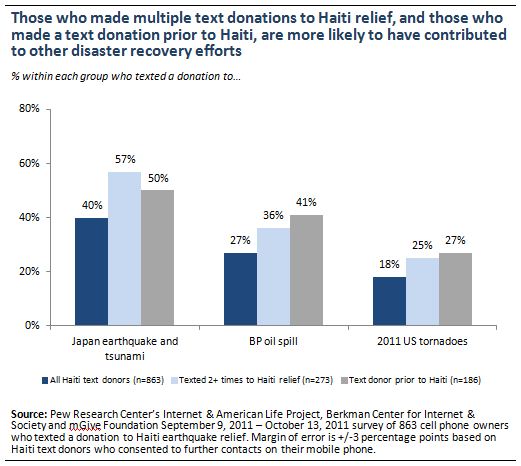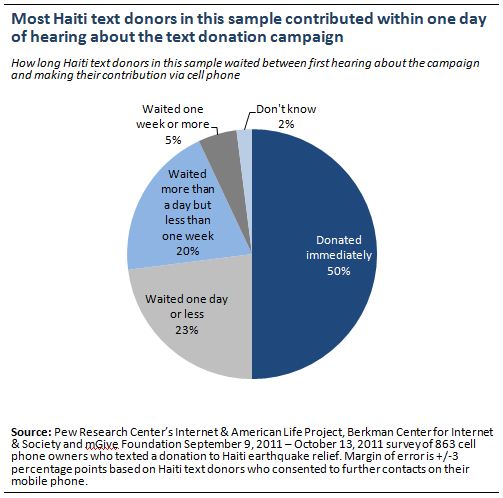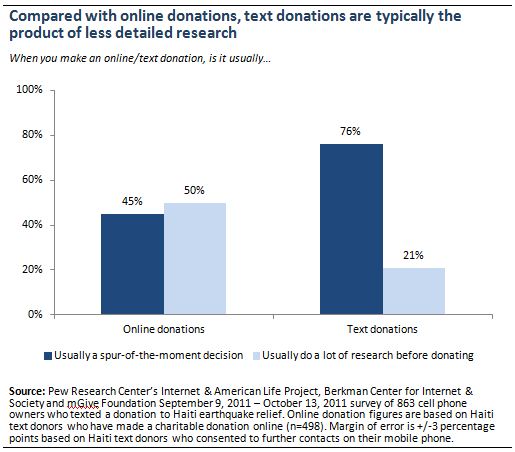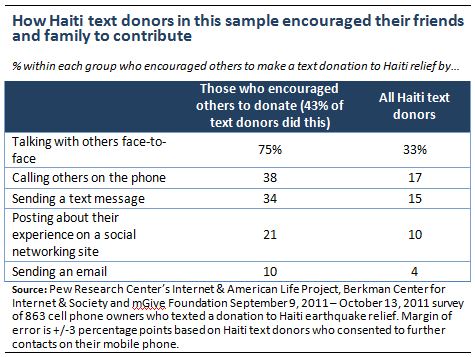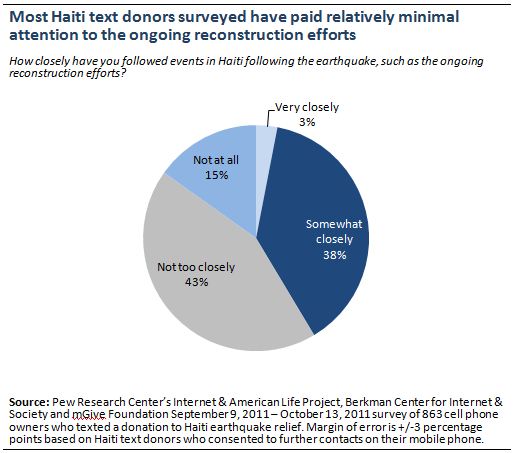Most Haiti text donors in this sample were first-time mobile givers who contributed to earthquake relief only via text message
Most of the Haiti text donors we surveyed were introduced to text giving by the Haiti disaster—three quarters (74%) say that their donation to Haiti earthquake relief was the first time they had used their phone’s text messaging function to make a donation to an event, cause or organization. One in five (22%) had texted a donation of some kind prior to their contribution to Haiti earthquake relief, and 5% are not sure whether they had done so before. Young adults and lower income respondents were a bit more likely than average to say that this was the first time they had made a text message contribution.
Overall, two-thirds of Haiti text donors in our survey (67%) made a single text message donation to earthquake relief. An additional 23% donated to the cause twice using their cell phone, and one in ten (9%) did so three or more times. African American and Latino text donors are more likely than white donors to have made multiple contributions using their mobile phones (41% of black and 40% of Latino text donors did so, compared with 28% of whites). Otherwise most of the donors we surveyed made a similar number of contributions using their mobile phone. Notably, first-time donors in the Haiti group were no more or less likely to make multiple contributions than those who had texted a donation to a cause previously.
Along with being mostly first-time text donors, a sizeable majority of mobile givers in our survey contributed to earthquake relief using only their cell phone. Eight in ten (80%) did not donate to Haiti relief in any other way, while one in five (19%)—in addition to their text contribution—donated some other way such as online, in person, or via regular mail. Combining those who made multiple donations using their cell phone and those who made a text donation plus some other kind of contribution, a total of 42% of the Haiti text donors surveyed made more than one contribution to Haiti earthquake relief.
More than half of these mobile donors made text contributions to other disaster recovery efforts following the Haiti earthquake
A majority of Haiti text donors surveyed (56%) contributed to other disaster recovery efforts using the text messaging feature on their cell phones following their donation to Haiti earthquake relief. This includes those who:
- Texted a donation to groups helping people living in Japan following the March 2011 earthquake and tsunami (40% of those surveyed did this).
- Texted a donation to groups helping people living in the US Gulf region following the 2010 BP oil spill (27%).
- Texted a donation to groups helping victims of the 2011 tornadoes in the United States (18%).
Haiti text donors who went on to text contributions to other events are not demographically distinct from those who did not. However, those individuals who made multiple contributions to Haiti relief, or who had texted a contribution to another cause prior to the Haiti campaign, were more likely to contribute via text message to later disaster relief efforts.
In addition to the specific disaster recovery efforts asked about in the survey, 29% of these Haiti text donors volunteered that they had texted a donation to some other organization or cause besides those listed above. Some of the more common responses included:
- Groups that provide a range of services, such the Red Cross or United Way (7% of Haiti text donors in this sample mentioned making a contribution via text message to this type of organization).
- Other disaster relief efforts such as those for Hurricane Katrina or the 2004 Indian Ocean earthquake and tsunami (6%).
- Disease research organizations such as the American Cancer Society, Stand Up To Cancer or St. Jude Children’s Research Hospital (4%).
- Animal welfare organizations such as The Humane Society or PETA (2%).
- Public media or NPR, military or veteran’s groups, famine relief efforts and environmental causes (each of which were mentioned by less than 1% of survey respondents).
Most Haiti text donors in this sample say that their contribution to Haiti relief (and text giving more generally) was a quick decision involving minimal research
When asked how long they waited between first hearing about the text donation campaign for Haiti and actually donating, half of the Haiti mobile donors surveyed (50%) say that they donated immediately upon hearing about the effort. An additional 23% did not donate immediately, but did do so within a day—meaning that three-quarters of these donors made a contribution on the same day they first heard about the campaign. One in five (20%) waited between one day and one week before making a contribution, while a small number (5%) waited a week or more to donate.
Even for those individuals who waited for a period of time before donating, their decision to donate was generally not the product of additional in-depth research. Those donors who did not contribute immediately, were asked whether they did any additional research about the organization they were donating to or how their money would be spent—and 70% said that they did not do this research. Thirty percent (30%) of those who waited to donate say that they did conduct additional research. But since half of all Haiti text donors surveyed contributed immediately, that means that just 14% of all donors in our sample researched where their money would be going before texting their contribution.
This tendency towards “impulse giving” via text message extends not just to their contribution to Haiti relief, but to their views of mobile giving more generally. In our survey we asked these donors whether their online and text message contributions to various organizations are usually a spur-of-the-moment decision, or whether they usually do a lot of research before making their contribution. For online donations, responses were split evenly—45% say that these contributions are usually spur-of-the-moment, while 50% say that they tend to research their decision beforehand. For text donations on the other hand, quick decisions are the norm—fully 76% say that these contributions usually involve minimal research.
The overwhelming majority of donors in this sample found out about the text-for-Haiti campaign on television
Information about how to text a donation to the Haiti relief efforts appeared in numerous venues, but television is overwhelmingly the main place that these donors recall seeing this information. When asked where they remember seeing information about the campaign, nine in ten (89%) mention television—by comparison, just 4% mention the internet, 3% mention an online news story or blog post, and 2% each mention the radio, text messages or posts on social networking sites.
How Haiti text donors in this sample spread the word about their contribution
Just under half (43%) of the Haiti text donors surveyed indicate that they encouraged friends or family members to make a similar contribution using their mobile phones (56% did not do this). Demographically, young adult and non-white donors were more likely than others to encourage friends or family members to make a text donation—just over half of black (53%), Latino (55%) and 18-29 year old (54%) text donors in this sample did so.
When asked how they went about encouraging others to contribute, by far the most common response was through face-to-face conversations—75% of those who encouraged others to make a contribution, did so via in-person discussion. Roughly one third encouraged others to donate by making a phone call or sending a text message, while one in five encouraged others to donate by posting about their experiences on a social networking site such as Facebook or Twitter. Email was the least common approach: just 10% of those who encouraged others to donate, did so by sending an email.
Overall, these requests were largely successful—76% of these “encouragers” say that their friends or family members did in fact make a donation via text message. Very few (6%) say that none of their friends or family members made a donation, and 18% are not sure if this happened or not. By contrast, just 33% of those who did not encourage others to make a text donation are aware of a friend or family member who contributed to the campaign, although a large number of these individuals (40%) are not sure if this happened or not.
Most of the Haiti text donors surveyed have not closely followed the post-earthquake reconstruction efforts
After making their contribution to earthquake relief, relatively few Haiti text donors in this sample have continued to monitor the ongoing reconstruction efforts. Just 3% of these donors have been following post-earthquake events “very closely”, while a total of six in ten say that they have been following these events either “not too closely” (43%) or “not at all” (15%).
Although the respondents in our sample had agreed to receive additional follow-up communications from the organization they donated to, most did not recall receiving any additional contacts—80% say that they have not received any such follow-up communications, compared with 17% who have.
